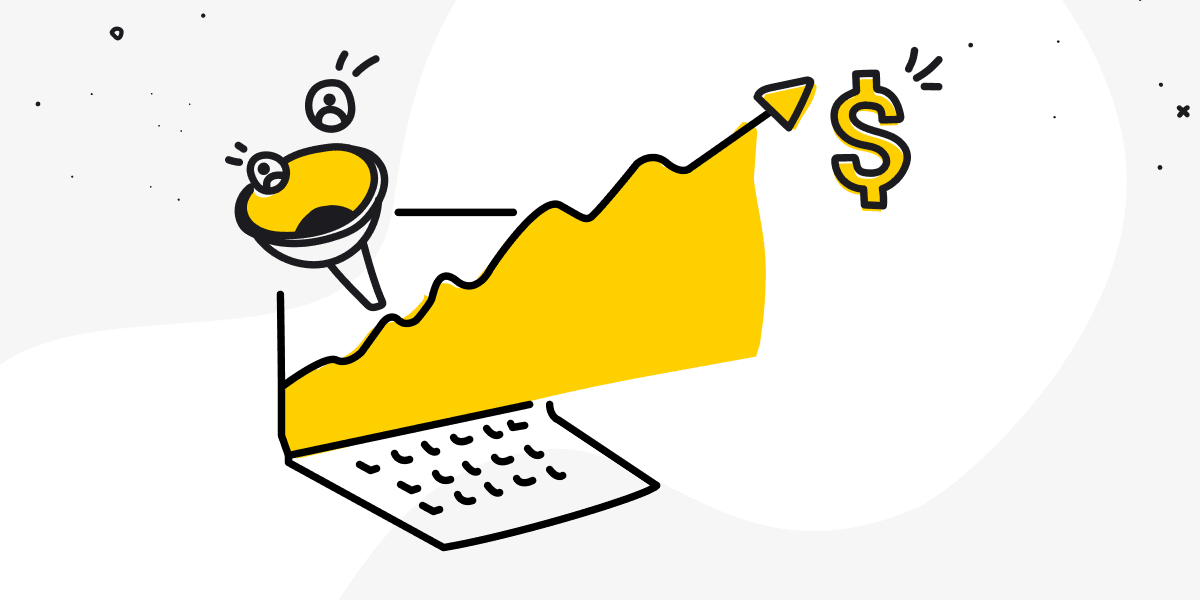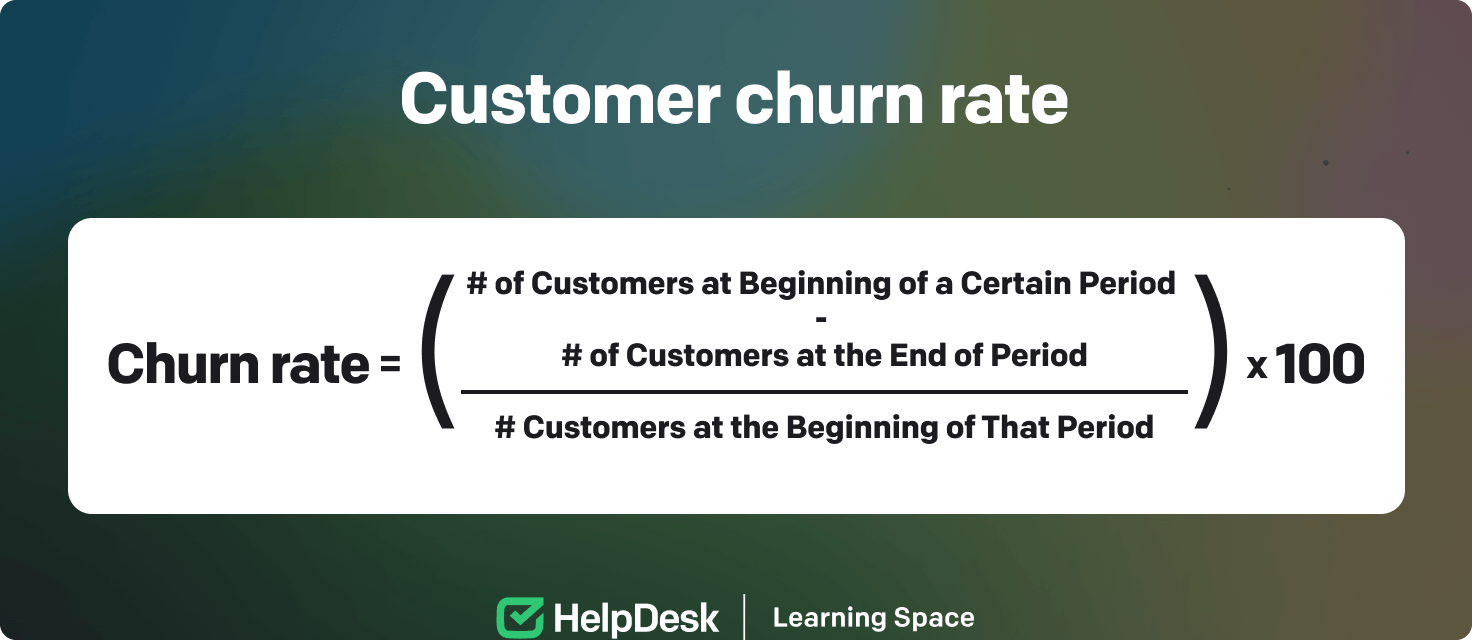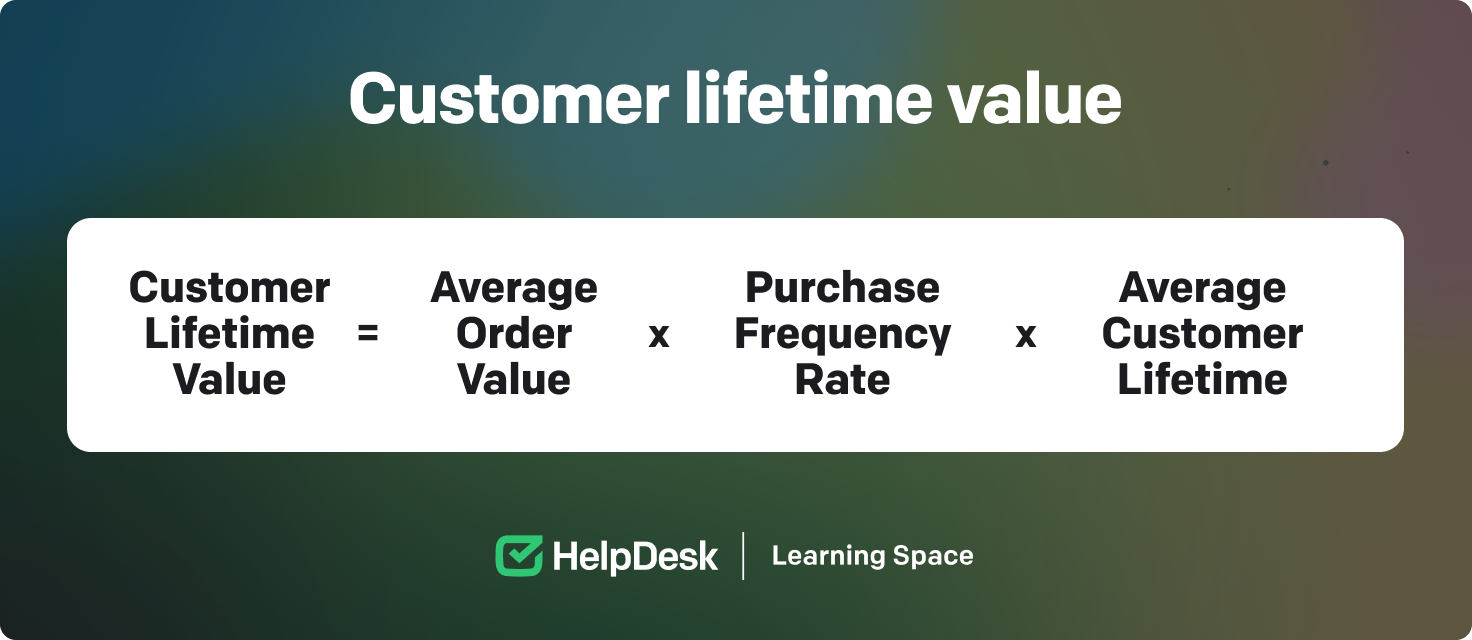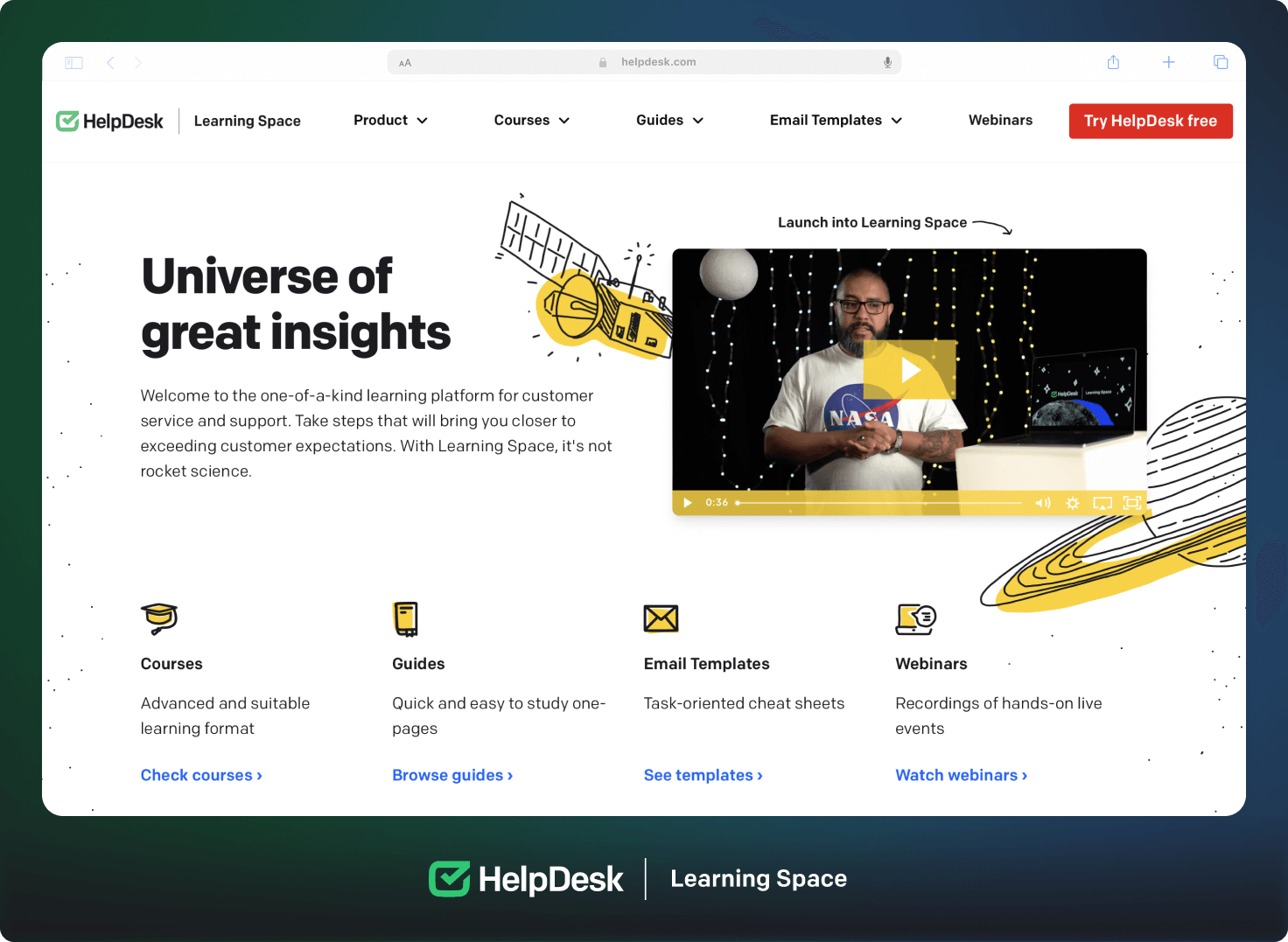


Busy supporting customers? Not anymore.
Watch hands-on webinar on workflows and easily automate your work in just five minutes!

Customer retention is a metric that indicates the level of consumer loyalty and satisfaction. It shows how well a company can keep its customer base. It’s particularly crucial for subscription-based businesses and service providers as it directly impacts long-term revenue.
Although a 100% retention rate is ideal, realistic targets vary by industry. For instance, small businesses may aim for about 20% retention, while ecommerce companies should aim for over 35%.
The importance of customer retention becomes evident when you consider that repeat customers tend to spend 67% more over time than first-time customers do. Moreover, customer retention is essential in promoting brand recognition and authority in the industry.
Do you want to stay connected with your customers across multiple platforms?
✅ Use HelpDesk, a ticketing system that efficiently manages your customer retention.

As I mentioned above, customer retention helps increase the company’s profits, but there are several other reasons why you should focus on returning customers.
Improving business performance can be directly linked to strategic efforts to upsell, cross-sell, and retain existing customers. Offering upgrades or additional products to your current customer base is a highly effective way of increasing revenue.
It’s because it’s generally easier to convince existing customers to make additional purchases than to acquire new ones due to the established trust and familiarity with your product.
Zendesk research shows that 81% of the customers surveyed are more likely to return to a company after a positive experience.
Establishing customer loyalty with long-standing customers positively impacts your revenue. Loyal customers are more likely to buy from trusted companies and their sister brands, resulting in increased engagement, satisfaction, and profits.
A prominent study by Bain & Company highlights the potential profitability associated with customer happiness. The study found that online shoppers who were satisfied with their chosen online retailers demonstrated a greater willingness to diversify their purchases.
Your business needs to build and maintain strong customer relationships. Retaining customers is vital to fostering loyalty and creating brand ambassadors who will share their positive experiences with others.
According to Yotpo, an impressive 60% of consumers engage in conversations about brands to which they’re loyal.
It’s more profitable to keep your current customers than always to attract new clients because loyal customers provide a consistent revenue stream, and the increased retention rates lead to exponential growth and higher customer retention over time. In contrast, acquiring new customers is expensive, requiring marketing spend and outreach, making the process less cost-effective.
Prioritizing customer acquisition and retention secures ongoing business and provides a more sustainable growth path. The chart emphasizes the importance of nurturing existing customer relationships as a strategic advantage in building a thriving business.
Understanding key customer retention metrics is essential for your business to create the best strategy. But what are these metrics? How do you measure them? Which are the most important? I’ll explain everything below.
Customer retention rate (CRR) tells us the proportion of customers who remain loyal to the business. To calculate the CRR, you need to identify three key figures:
Customers at the start of the given period (S).
Customers at the end of that period (E).
Customers added during that period (N).
You can evaluate the success of customer retention by plugging the correct values into the equation, which helps to adjust strategies to increase customer loyalty. CRR monitoring plays a significant role in understanding customer relationships, guiding effective business decisions, and supporting sustainable growth.

The customer churn rate is the percentage of customers who end their business relationship with you within a given period. High churn rates often indicate difficulties in maintaining customer loyalty.
If a business experiences a high customer churn rate or low retention rate, it could imply customer journey issues, like unmet expectations, poor product or service experience, or the availability of better and more affordable alternatives. In subscription services, reasons for churn may include expired payment methods or network failures.
You must remember to collect customer feedback, identify customer complaints, and understand the factors contributing to them to reverse the trend of high customer churn rates. This will allow you to develop effective strategies to improve customer retention.

Customer lifetime value (CLV) is a metric that measures the total revenue a company can expect to earn from a customer throughout their entire relationship with the company. The idea behind CLV is simple: the longer a customer stays loyal to a company, the greater their lifetime value becomes.
Retention marketing is crucial here. You can increase customer goodwill and value by improving purchase frequency and average order value metrics.

The returning customer ratio measures the percentage of customers willing to make a repeat purchase from your company.
Calculating this ratio is a simple process that requires just two pieces of information: the number of customers who have made more than one purchase and the total number of unique customers. The former represents customers who have made more than one purchase in a specific period, usually a year, for a comprehensive overview. The latter refers to the number of distinct customers who made purchases during the same period, as opposed to the number of orders placed.

The purchase frequency metric determines how often customers visit the store to make purchases. Repeat buyers usually make up a significant portion of a store’s yearly revenue. To calculate this metric, divide the number of orders placed during a specific period by the number of unique customers.
Tracking how often customers make purchases enables you to modify strategies, increase customer engagement, and achieve long-term success.

Alright, now you know everything you need about why customer retention matters. So you and I can dive deep into the best strategies for 2024.
A satisfied employee = a positive customer experience. Can you imagine coming to a clothes store where you need advice on choosing a suit, and an unhappy store employee throws two random pieces at you and tells you to select something? It certainly wouldn’t be a positive experience.
Motivating employees to engage with customers fosters trust, increasing clients’ loyalty even under challenging situations. A positive work environment reduces turnover rates by ensuring experienced employees remain attuned to customer needs. Employee satisfaction translates into better service quality, contributing to improving the overall customer experience.
Your company must have a feedback loop. This loop is essential in improving your teams and products. You can establish a process for collecting feedback through various methods such as surveys, tests, or simply asking for feedback after customer interactions.
After collecting feedback, analyze the results to identify trends in customer behavior and areas where you can improve the user experience. You can share this information with the appropriate teams to implement targeted improvements.
Customers like to be treated personally. That’s why good support interactions are so meaningful.
Providing customer service agents with the appropriate tools is essential to tackle this challenge. For instance, it would be beneficial to implement a suitable tool for managing customer inquiries, such as HelpDesk. Thanks to it, agents get access to important customer information, queries, and issues quickly and effectively to provide solutions.
Additionally, it’s worth considering whether your customer support builds relationships with its customers well. You can learn more about this topic with our guide on Customer relations in support: Definition, benefits, and instructions.

The subscription model is one of the best methods for increasing customer retention and capturing customers. According to research, 15% of online shoppers have already signed up to receive products regularly.
To attract more customers to subscribe, offer exclusive benefits or products tailored to their current needs. This provides convenience, fosters loyalty, and creates a steady revenue stream, delivering ongoing value to customers.
Besides, how many times have you forgotten to cancel your subscription?
It’s essential to be available to your clients on all necessary channels. Support across multiple platforms allows customer service agents to access relevant information and personalize customer experiences.
For instance, HelpDesk offers a ticketing system that works across various platforms. It simplifies the customer support process and helps you stay organized using a single dashboard with many valuable features.
Discover a streamlined HelpDesk ticketing system with essential customer service features to delight your customers. 🤝
“Sometimes less is more” is also a famous saying for businesses. Providing a product or service that addresses a specific problem is essential, but not every problem necessarily requires a solution. By focusing on a particular issue important to your customers, you can develop a more refined solution tailored to your specific segment.
This approach helps create a more effective and customized solution and increases end-user happiness and loyalty in your niche. Ultimately, by speaking to everyone, we end up talking to no one, so narrowing our focus and delivering a solution that meets the needs of our target audience is essential.
It’s also worth taking care of education. Initiating a customer education program is a long-term investment in your customer base. You can create self-service tools like a knowledge base or a community forum.
On these platforms, customers can proactively find solutions to service issues, reducing the need to contact the support team. Education program goes beyond product-specific information and provides a comprehensive source of information to offer customer service that strengthens customer positioning and loyalty.
Check out the HelpDesk Learning Space to gain more knowledge about customer service.

Another strategy is providing quick delivery options. Although some customers are willing to wait weeks for a product, offering expedited delivery appeals to those who prefer immediate gratification.
You can meet the urgent needs of some customers and increase their overall attractiveness by guaranteeing faster delivery than the competition.
Improving software quality is essential for retaining customers. Upgrading software enhances user experience, resolves issues, and boosts customer satisfaction. A well-designed interface, practical features, and frequent updates contribute to loyalty.
You need to go beyond just transactions to create meaningful connections with customers. Integrate company values with brand identity.
Whether eco-friendliness, charitable initiatives, or keeping up with current trends, sharing these values helps customers identify with your brand. When customers feel they resonate with your values, it creates a sense of connection and belonging, strengthening the bond between your company and its customers.
To improve your customer management and increase their loyalty to your brand, it is worth investing in CRM (customer relationship management) systems. This software will empower you with tools that will enable you to improve loyalty management within your company.
Customer retention is a key aspect of business success. To prove this, here are some ways top companies prioritize customer retention.
Starbucks has a history of loyalty marketing innovation, particularly in customer acquisition. In its early days, founders Zev Siegl, Jerry Baldwin, and Gordon Bowker focused on creating a delightful customer experience with the ambiance of their shops.
They knew they had to develop new ideas to grow their business. One of their successful strategies was introducing the Mobile Order & Pay feature in their app, which helped them retain customers. The feature allows customers to order and pay for their coffee before arriving at the shop, making the process more convenient.
The main takeaway is always to make your products and services easily accessible to your customers.
 Source: https://www.starbucks.pl/en/delivers
Source: https://www.starbucks.pl/en/delivers
Suppose you want to be the preferred choice for your customers over your competitors. In that case, you can learn a valuable lesson from Apple’s marketing strategy, exemplified by their “Mac vs. PC” advertisement campaign. This campaign featured John Hodgman as the bumbling PC and Justin Long as the suave Mac, and it humorously highlighted why Mac was the superior choice. The campaign was cheeky, sparked debate, and strategically positioned Apple by identifying its target consumer base.
It’s important to remain true to your brand and maintain integrity, as this attracts customers who may become your most loyal advocates. Whether you champion a cause or infuse your story with passion, don’t avoid bold marketing tactics to achieve optimal results.
 Source: https://www.apple.com/
Source: https://www.apple.com/
Tesco, a major UK supermarket chain, boasts nearly 4,000 nationwide stores. For large brands like these, conveying authenticity can be challenging. While online shopping and self-service scanners offer convenience, the human touch remains crucial. Tesco tackles this by using X (formerly Twitter) as a help desk to provide customer service with a personal touch, injecting personality into their interactions.
 Source: https://twitter.com/Tesco/with_replies
Source: https://twitter.com/Tesco/with_replies
Implementing a subscription service differs for a commodity-based organization, but Amazon broke the norm with Prime. Initially designed for faster delivery, the subscription caused controversy but quickly became popular among regular shoppers.
To use subscriptions to grow and retain customers, consider offering exclusive content and events without charging a fee. Learn from Amazon by ensuring that your subscription provides something desired, highlighting the importance of understanding your audience’s needs and challenges in customer development.
 Source: https://www.amazon.com/amazonprime
Source: https://www.amazon.com/amazonprime
Developing your company’s reputation and fostering customer loyalty is a gradual process. By dedicating yourself to an excellent support center and leveraging robust software, you can inch closer to gaining your customers’ trust. You should also remember to take care of loyalty programs, as they can help you increase your customer satisfaction.
Utilize HelpDesk, a ticketing service desk, to engage with your customers effectively. With cutting-edge customer service features, including multichannel connectivity, integrated support, and AI-powered features, you’ll be on the path to creating a customer experience that garners rave reviews.
Remember to check the HelpDesk Learning Space for more insight into customer support!
Zuzanna Bocian
Zuzanna is a Content Automation Specialist in HelpDesk. She claims to have the coolest job in the world as she combines her passion for writing with new technologies, a passion she's had since childhood. In her free time, she likes to climb at the local gym, learn Spanish, and participate in modern dance classes.
Try HelpDesk for free
For quick and intuitive tickets management